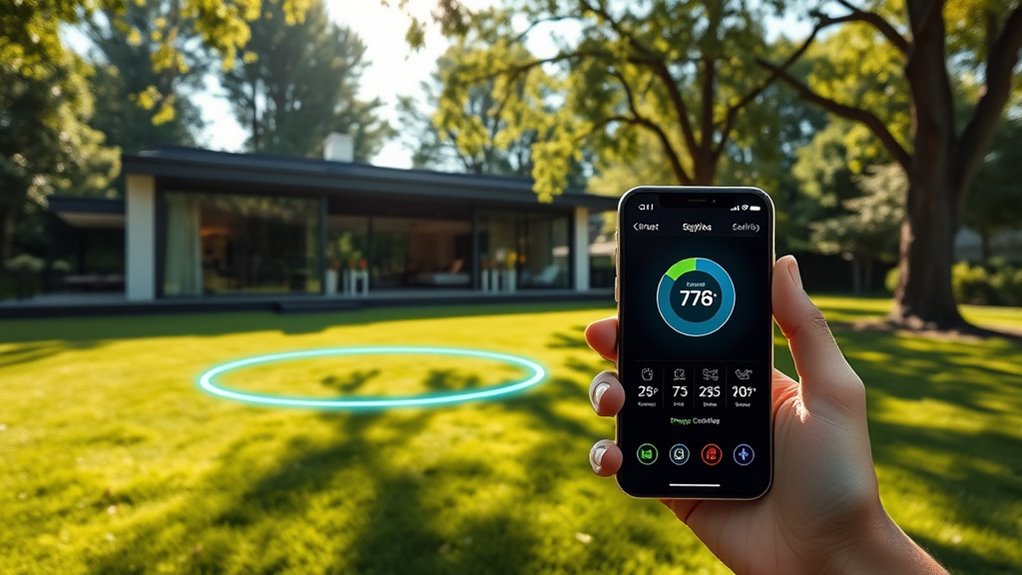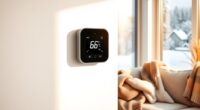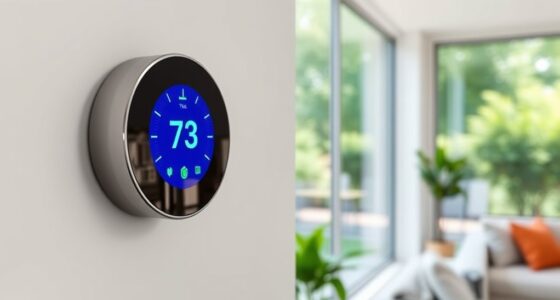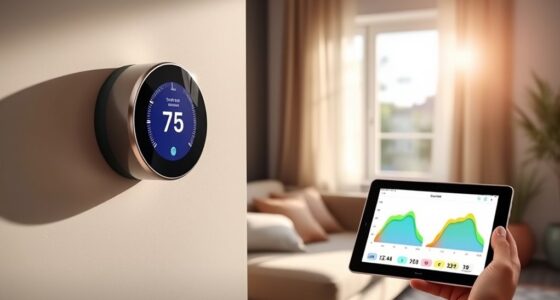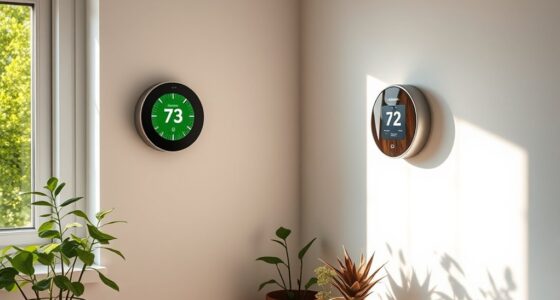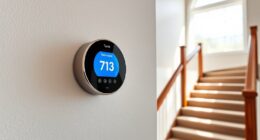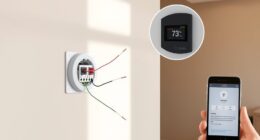Using geofencing with a smart thermostat helps you cut heating and cooling costs by automatically adjusting your system when you leave or approach home. When you’re away, it lowers energy use by turning off or reducing heating, and ramps up comfort before you return. This automation prevents unnecessary energy waste and saves money over time. If you want to discover more tips on maximizing your energy savings, keep exploring the possibilities.
Key Takeaways
- Geofencing automatically adjusts HVAC settings based on smartphone location, reducing energy use when the house is empty.
- Setting appropriate geofence boundaries helps prevent unnecessary heating or cooling during travel or absence.
- Automating temperature changes before arrival ensures comfort while minimizing energy expenditure.
- Regularly reviewing energy reports from the smart thermostat highlights savings achieved through geofencing.
- Combining geofencing with other smart home features optimizes overall energy efficiency and cost reduction.

If you want to cut down on energy bills, using geofencing technology can be a game-changer. By leveraging a smart thermostat combined with location tracking, you can automate your heating and cooling system to operate only when you need it. This means your HVAC system doesn’t run unnecessarily when you’re not home, saving you money over time. When your smartphone enters or leaves a designated zone around your house, the system adjusts accordingly, turning off or reducing heating and cooling when you’re away and ramping up comfort as you return.
With a smart thermostat that supports geofencing, setting up the system is straightforward. You’ll typically use an app on your phone to define the geofence — a virtual boundary around your property. Once set, the thermostat uses location tracking to monitor your phone’s position in real-time. When it detects you’re leaving, it can automatically lower the temperature in winter or raise it in summer, ensuring you’re not wasting energy heating or cooling an empty house. Conversely, as you approach home, the system ramps back up to your preferred comfort settings just in time for your arrival.
Set your geofence and let your thermostat automatically adjust comfort levels as you arrive or leave.
This approach not only saves energy but also enhances convenience. You won’t have to remember to manually adjust your thermostat or worry about forgetting to turn it off before leaving the house. The automation runs seamlessly, giving you peace of mind and reducing your carbon footprint. Plus, many smart thermostats provide detailed energy usage reports, so you can see the tangible savings your geofencing setup achieves over weeks and months. Incorporating sound design principles such as clear feedback sounds can also improve user interaction with the system.
It’s important to note that location tracking is key here. It uses GPS or Wi-Fi signals from your smartphone to determine your whereabouts. Because of this, it’s a good idea to ensure your phone’s location services are always active when you want the automation to work efficiently. Some systems even allow multiple user profiles, so everyone in your household can benefit from the savings and convenience.
To maximize effectiveness, customize the geofence radius to match your typical travel distance, whether you’re just leaving for work or heading out for errands. You can also set specific schedules or override options if needed, providing flexibility for special occasions or irregular routines. Over time, these smart adjustments can considerably cut your heating and cooling costs, all while maintaining a comfortable home environment. Using geofencing with a smart thermostat and location tracking offers a smart, efficient way to manage your energy use without sacrificing comfort.
Frequently Asked Questions
Can Geofencing Be Integrated With Existing Smart Home Systems?
Yes, you can integrate geofencing with your existing smart home systems, but you might face some compatibility issues. Check if your smart home devices support the geofencing feature or if they can connect through a compatible hub or platform. System integration challenges can arise, so it’s vital to confirm smart home compatibility beforehand and guarantee all devices work seamlessly together for effective energy savings.
What Are the Privacy Implications of Using Geofencing Technology?
Privacy pitfalls pose significant concerns with geofencing, as your location tracking can reveal private routines. You must consider how your data security is maintained and who has access to your movement data. Stay vigilant about permissions and the privacy policies of your smart systems, ensuring your personal information remains protected. By understanding these privacy implications, you can confidently enjoy the benefits of geofencing while safeguarding your sensitive data.
How Accurate Is Geofencing in Detecting User Location?
Geofencing’s accuracy depends on sensor accuracy and location precision, which can vary based on your device and network. Usually, it detects your location within a range of a few meters to several hundred meters, making it fairly reliable for many applications. However, factors like GPS signal strength, indoor positioning, and device quality can influence how precisely it tracks you, so occasional inaccuracies might occur.
What Are the Initial Setup Costs for Geofencing Systems?
Setting up a geofencing system is like planting a seed—you’ll want to invest upfront. The initial costs include installation expenses and equipment costs, which can vary based on your home’s size and system complexity. Generally, you might spend a few hundred to over a thousand dollars. While it seems like a big step now, think of it as planting the foundation for ongoing savings and smarter energy use.
Does Geofencing Work if the Smartphone Battery Is Dead?
No, geofencing won’t work if your smartphone’s battery is dead because of its battery dependency. When your battery dies, the system can’t track your location, making it impossible to trigger heating or cooling adjustments. Also, with a dead battery, location accuracy becomes irrelevant since the device can’t send any data. To guarantee reliable geofencing, keep your phone charged and ensure location services are enabled.
Conclusion
By harnessing geofencing, you’re fundamentally giving your home a sense of awareness, like a vigilant guardian that adjusts itself to your presence. This smart technology helps you cut costs and save energy, making your heating and cooling systems work only when needed. With geofencing, your home becomes a responsive partner, silently working behind the scenes to keep you comfortable while your energy bills stay low—turning everyday living into a smarter, more efficient experience.
